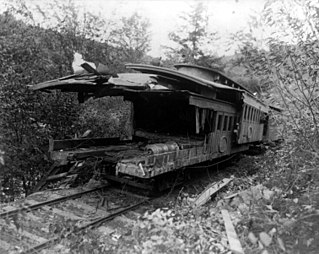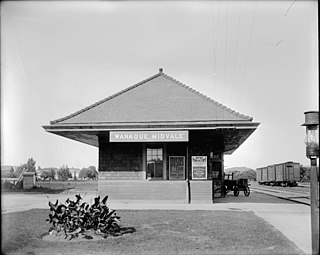
John Luther "Casey" Jones was an American railroader who was killed when his passenger train collided with a stalled freight train in Vaughan, Mississippi.

The Great Train Wreck of 1918 occurred on July 9, 1918, in Nashville, Tennessee, United States. Two passenger trains, operated by the Nashville, Chattanooga and St. Louis Railway ("NC&StL"), collided head-on, costing at least 101 lives and injuring an additional 171. It is considered the worst rail accident in U.S. history, though estimates of the death toll of this accident overlap with that of the Malbone Street Wreck in Brooklyn, New York, the same year.

The Great East Thompson Train Wreck was a large rail disaster which occurred in East Thompson, Connecticut, on December 4, 1891. It was one of the most extensive train wrecks in American history, and the first of two to involve four trains. It happened on the New York and New England Railroad, which provided a shortcut from New York City to Boston by making a diagonal across Connecticut. The railroad is now abandoned, and most of its tracks removed.

The Hammond Circus Train Wreck occurred on June 22, 1918, and was one of the worst train wrecks in U.S. history. Eighty-six people were reported to have died and another 127 were injured when a locomotive engineer fell asleep and ran his troop train into the rear of a circus train near Hammond, Indiana. The circus train held 400 performers and roustabouts of the Hagenbeck–Wallace Circus.

The Lackawanna Cut-Off was a rail line built by the Delaware, Lackawanna and Western Railroad (DL&W). Constructed from 1908 to 1911, the line was part of a 396-mile (637 km) main line between Hoboken, New Jersey, and Buffalo, New York. It ran west for 28.45 miles (45.79 km) from Port Morris Junction in Port Morris, New Jersey, near the south end of Lake Hopatcong about 45 miles (72 km) west-northwest of New York City, to Slateford Junction in Slateford, Pennsylvania near the Delaware Water Gap.
The Rennert railroad accident occurred in Rennert, North Carolina, on December 16, 1943. Seventy four people were killed when the northbound Tamiami Champion, an Atlantic Coast Line Railroad passenger train, struck the rear two cars of its southbound counterpart, which had derailed. It remains the deadliest train wreck ever in North Carolina.

The Naperville train disaster occurred April 25, 1946, on the Chicago, Burlington and Quincy Railroad at Loomis Street in Naperville, Illinois, when the railroad's Exposition Flyer rammed into the Advance Flyer, which had made an unscheduled stop to check its running gear. The Exposition Flyer had been coming through on the same track at 80 miles per hour (130 km/h). There were 45 deaths and some 125 injuries. This crash is a major reason why most passenger trains in the United States have a speed limit of 79 mph (127 km/h).

The Mud Run disaster was a train wreck that occurred on October 10, 1888, at Mud Run station in Kidder Township, Pennsylvania, on the Lehigh Valley Railroad. At 10 p.m., one train ran into the back of another, killing 64 people.

The Rockport train wreck occurred in Rockport in Mansfield Township, New Jersey, United States, about three miles outside of Hackettstown, on June 16, 1925. A violent storm washed debris onto a grade crossing, derailing a Lackawanna Railroad (DL&W) train. The crash killed 42 passengers and five crewmen and injured twenty-three others.
The Bagley train wreck occurred in Utah, United States, on the morning of Sunday December 31, 1944. The crash killed 50, including over 35 military personnel, and injured 81.
The Michigan train wreck was the worst rail disaster in both North Dakota and Great Northern Railway history. It happened on August 9, 1945, at Michigan, North Dakota, and involved Great Northern's premier train, the Empire Builder.

The Shepherdsville train wreck was a fatal rail accident that killed at least 49 people when an express collided with a local train at Shepherdsville, Kentucky on December 20, 1917. It was the deadliest train wreck in Kentucky's history. Blame was chiefly attributed to negligence by the driver and flagman of the local train, though the standard signalling routines were also found to be inadequate.

Wanaque–Midvale was a former commuter railroad station of the Erie Railroad's New York and Greenwood Lake Railway branch in Wanaque, New Jersey, United States. When built in 1873, the station served trains running from Pavonia Terminal in Jersey City to Sterling Forest on the New York–New Jersey border alongside Greenwood Lake and trains going to Ringwood on the Ringwood Branch. At the time there were two stations, one at Wanaque and one at Midvale. The next station northbound towards Sterling Forest was Boardville; heading towards Ringwood it was Erskine. The next station south was Haskell.
An accident occurred on the four-track mainline of the New York Central Railroad at 10:02 P.M. on March 27, 1953, 2.4 miles east of Conneaut, Ohio. It began when an improperly secured load of pipe broke loose from a gondola car on an eastbound freight train, damaging the westbound passenger track. A passing westbound freight crew notified the first train and stopped to assess what had happened, but a fast westbound passenger train could not stop and was derailed by the damaged track, colliding with the adjacent westbound freight. Finally, an eastbound fast passenger train struck the derailed equipment from the first two trains. There were 21 deaths and 49 people were injured. This accident holds the record for the most trains involved in a single accident.
The Lackawanna Limited wreck occurred when a Delaware, Lackawanna and Western Railroad (DL&W) passenger train, the New York-Buffalo Lackawanna Limited with 500 passengers, crashed into a freight train on August 30, 1943, killing 29 people in the small Steuben County community of Wayland in upstate New York, approximately 40 miles (64 km) south of Rochester.

The Baker Bridge train wreck occurred on November 26, 1905, in Lincoln, Massachusetts, when two passenger trains on the Fitchburg line of the Boston and Maine Railroad were involved in a rear-end collision. Seventeen people were killed in the wreck. Engineer Horace W. Lyons was charged with manslaughter; however, a grand jury chose not to indict him.
The Swampscott train wreck occurred on February 28, 1956, in Swampscott, Massachusetts when a Danvers–Boston commuter train crashed into the rear of a stopped Portsmouth–Boston local train just north of the station during a snowstorm. The collision, blamed on the engineer operating at unsafe speeds for the conditions, killed 13 people and injured 283.











